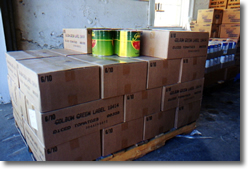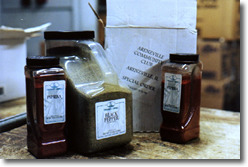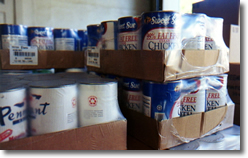| |
During the first stage of soup cooking when all the raw vegetables were added, the men worked at a constant pace in the repeated routine of weighing the ingredients, dispensing the vegetables in a bucket-brigade, stoking the fires and stacking more wood. Now it is time to add the canned ingredients -- tomatoes, chicken, chicken broth, and corn. It is important to wait for the last hours of cooking to add these ingredients, especially the corn, because they cook very fast and often stick to the bottom of the kettles.
Two heavy-duty can openers are mounted on the old wooden work table, and one of the men drives forward with a forklift to deliver a pallet of several dozen cans of tomatoes to the work area. Hondo Huey knows how many cans must go into each kettle, and the men gather around to start opening cans. "Now this," says Rus Lutkehus, referring to the can-opening job, "is a lot like work."
They work in assembly-line fashion, unpacking the cans from cartons, opening each can, and passing it forward down the line for another man to dispense into a bucket for delivery to the kettles. |

Lending a hand with the work, Harry Bentsen opens a can of tomatoes for use in the soup.
|
|
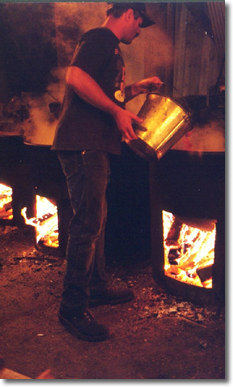
Joe Huey adds some tomatoes to the soup.
|
Using canned ingredients in the soup is a relatively recent innovation. Just over twenty years ago, the soup-makers solicited fresh ingredients from the community. One of the jobs in the weeks before the festival was to make the rounds among the residents in Arenzville and the surrounding area, requesting support in the form of cash or donated produce for the soup. One family might be able to provide several bushels of fresh tomatoes, another a half a dozen dressed chickens, and others would give up some of the sweet corn from their freezers or home-canned supply. Fresh produce is still provided for use at the Burgoo; for example, the sliced tomatoes at the hamburger stand this year all came from a local grower. But instead of relying on the community to supply all the ingredients for the soup, the Burgoo Committee now orders the fresh and canned goods from suppliers. (The cash donations are still very much welcomed.)
When the early burgoo-makers used freshly dressed hens in the soup, they of course put the whole carcass into the stew and removed the bones later. A cooking utensil similar to a large slotted spoon was used to retrieve the larger bones, but it was impossible to remove all the small pieces. When one ate burgoo in those days, he was well advised to examine each spoonful for chicken bones. These small culinary intrusions were unappetizing for some people but considered by others to be evidence of true home cooking, adding to the mystique of the soup. |
Today, however, the cooks use boneless canned chicken and fat-free chicken broth. The beef which makes the initial stock comes from Jones Meat Locker, which delivers the meat cut and ready to go into the kettles. "They provide good quality meat, too" says Don Wessler. "We don't get the 'throw away' beef chunks, and I'm convinced that it's one of the reasons the Arenzville soup is so good."
Once the tomatoes have been added, the forklift moves forward again, this time with a pallet full of canned chicken and chicken broth. Hondo stops to figure for a moment, then prescribes four cans of chicken and two cans of broth for each kettle. After counting out the number of cans which must be reserved for the three kettles to be started later that morning, the crew sets to work opening the canned chicken. As fast as the cans are opened, they are dumped in a bucket to distribute down the line.
| When the last kettle gets the measured amount of chicken, the crew finds that they have opened two extra cans. This causes momentary confusion while they sort out the reason for the surplus. While two excess cans of chicken might not seem like a catastrophe, this group is also concerned about the amount of chicken needed for the kettles yet to be started. They don't want to leave the next crew without the exact amount needed, and they are extremely serious about the consistency of preparation from one kettle to the next. Once it is determined that the remaining supply of unopened cans is sufficient, the decision is made to divide the excess amount of chicken evenly among the twelve kettles at hand. It amounts to about two-thirds cup to be added to each seventy-five-gallon kettle, and Craig Gregory dutifully doles it out. |

Craig Gregory empties the last bit of chicken into a kettle.
|
|
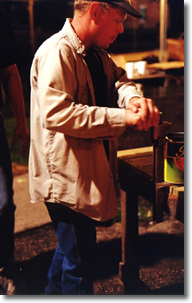
Gale Kleinschmidt
|
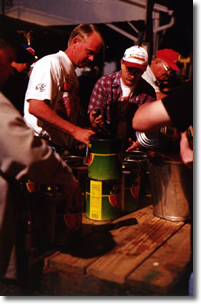
Marc Carls and Rus Lutkehus
|
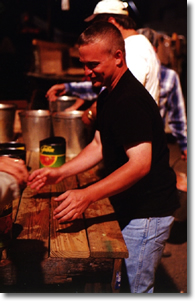
Steve Stocker
|
The next ingredient to be added is the chicken broth, and without realizing that he is opening the first can of broth, Rus reacts with surprise when he empties a can into a bucket. He was expecting boned chicken to plop into the bucket, but when the liquid pours out, he yells, "Hey! There's nothing in here but water!!" The whole group bursts out laughing and then jumps to stop him before he empties the bucket onto the ground. "No! It's broth!" they tell him. He enjoys the joke on himself and sends off another round of laughter when he says he thought they had gotten cheated on a can of chicken.
Around 4:30 in the morning, the last canned ingredient is added when the corn goes into the soup. In just three short hours, says Don, people will start showing up for kettle service. "We usually try to start kettle service around 8:00 in the morning," he says, "but we have had people show up as early as 6:30, wanting to get some soup." Most of the soup prepared tonight will be sold through the kettle service, which means that the soup is sold in quantities of a quart or more and carried off in containers. Kettle service is provided on both days of the Arenzville Burgoo, but the demand is much greater on the first day.
On a table near the kettles, Hondo and Joe Lovekamp are preparing to add salt and pepper to each kettle. Each kettle gets a full container of salt (think about that before you grab the salt shaker to add to your bowl), and the amount of pepper is equivalent to whatever space is available in the top of the opened salt container, or about five or six tablespoons.
The group has thinned out considerably now, and already some of the morning crew has started to show up. It's nearly 5:00 a.m., and Hondo is getting ready to add the last ingredient -- paprika. Knowing that I still have a full day ahead of me, I decide that this is a good time to go home. The house is quiet when I finally crawl into bed. Outside my window it is still dark, but it won't be long before dawn breaks and the 1998 Arenzville Burgoo begins. |
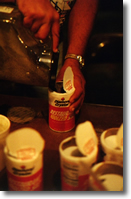
Adding pepper to a salt container. One canister of these combined ingredients goes into each kettle.
|
Continued ...
|
 ARENZVILLE, IL | HOME OF THE WORLD'S BEST BURGOO
ARENZVILLE, IL | HOME OF THE WORLD'S BEST BURGOO 

